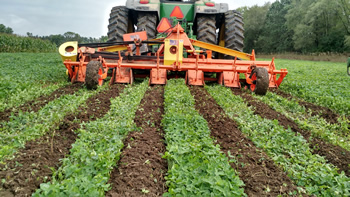Principal Investigator: Julie Grossman
Organization: University of Minnesota, Department of Horticultural Science
Award Amount: $232,244
Start Date: 5/9/2014 | End Date: 6/30/2017
Project Manager: Heidi Peterson
FINAL REPORT is available in the Minnesota Water Research Digital Library
Project Summary
 This project tested three methods of field preparation for corn with the goal of developing more effective methods to establish corn in cover crops and living mulches. The objective was to reduce negative effects that cover crops and living mulches may have on the early growth of corn seedlings. The three methods included: no-till, strip till, rotary zone till (a novel strip till that is wider but shallower than traditional strip till), and both strip till units together.
This project tested three methods of field preparation for corn with the goal of developing more effective methods to establish corn in cover crops and living mulches. The objective was to reduce negative effects that cover crops and living mulches may have on the early growth of corn seedlings. The three methods included: no-till, strip till, rotary zone till (a novel strip till that is wider but shallower than traditional strip till), and both strip till units together.Research focused on eliminating the yield gap between conventional corn and corn produced in a perennial living mulch system. This research was conducted over two growing seasons at the University of Minnesota’s Research and Outreach Centers in Rosemount and Waseca.
Summary Conclusions
- Rotary zone tillage is a promising strategy for managing kura clover living mulch in corn systems in the Upper Midwest.
- Combining the shallower rotary zone tillage approach with the deeper shank tillage approach provided more soil inorganic nitrogen available for corn uptake than the traditional shank till approach alone.
- The quantity of above ground kura clover biomass plays a critical role in governing carbon (C) and nitrogen (N) cycling in the living mulch systems, providing more labile soil C and higher available N when more kura clover biomass is present.
- Kura clover zone till management requires careful attention, particularly during the early season. During this critical period, corn grown in seedbeds prepared with rotary zone tillage was consistently ahead of corn grown in seedbeds prepared using traditional strip tillage.
- Rotary zone tillage led to higher grain yields than strip tillage in one of our two study years.
- Although promising, the rotary zone tillage system requires more capital input for implement purchase. Living mulch systems in general use might be best suited for more sensitive environments and those at high risk for water quality challenges, due to these increased management costs and potentially higher labor needs.
Background
Use of winter cover crops can decrease soil erosion, suppress weeds, and minimize the amount of runoff leaving a field. Cover crops have also been shown to improve soil health. However, less research has focused on living mulch systems where the perennial legume cover, such as kura clover or alfalfa, is not completely terminated; rather, strips for planting the cash crops are created either chemically with herbicides or physically with strip tillage. Perennial legumes provide all the environmental benefits of a traditional winter cover crop, but also promote nitrogen fixation and increase the overall amount of nitrogen in the system.
Any plant material grown in the same field as a row crop has the potential to negatively affect crop yield. The goal is to overcome these hurdles and capture the environmental benefits of cover crops and living mulches by understanding and eliminating the mechanism of yield loss.
Project Description
The Rosemount site focuses on an established kura clover living mulch system, while research at Waseca focuses on winter annual cover crops with an emphasis on a cereal rye/hairy vetch mixture. Living mulches are not terminated at the time of row crop planting; instead, strips for planting are created either with herbicides or cultivated. The cash crop is planted directly into the strip.
Hypothesis
The general hypothesis is that rotary zone tillage will produce both higher yields and greater environmental benefits than current practices.
Specifically, novel rotary zone tillage will:
- provide more rapid nitrogen mineralization for the subsequent corn crop,
- maintain lower nitrate leaching losses,
- increase active soil carbon pools and microbial activity (both proxies for soil health),
- provide a more favorable light environment for cash crop seedlings,
- provide earlier and more consistent emergence, and
- result in higher corn yields.
Deliverables
- Results guiding whether to accept or reject the hypothesis regarding the water quality benefits and effectiveness of the cropping systems tested.
- An extension bulletin providing guidelines for growing living mulch and cover crop systems for corn.
- Two peer-reviewed journal articles focused on 1) agronomic considerations and 2) environmental benefits (or ecosystem services).
Outreach and Education
Farmers:
- The University of Minnesota Research and Outreach Centers at Morris, Lamberton and Waseca will host field days focusing on the dual-purpose cropping system.
- Development and distribution of a dual-cropping system grower’s guide.
Students:
- Support of two graduate students, a postdoctoral research associate, and an undergraduate researcher who are directly involved in the dual-purpose cropping system research.
Professionals:
- Development of peer-reviewed journal articles
- On-campus seminars
- Field days focusing on dual-purpose cropping systems

